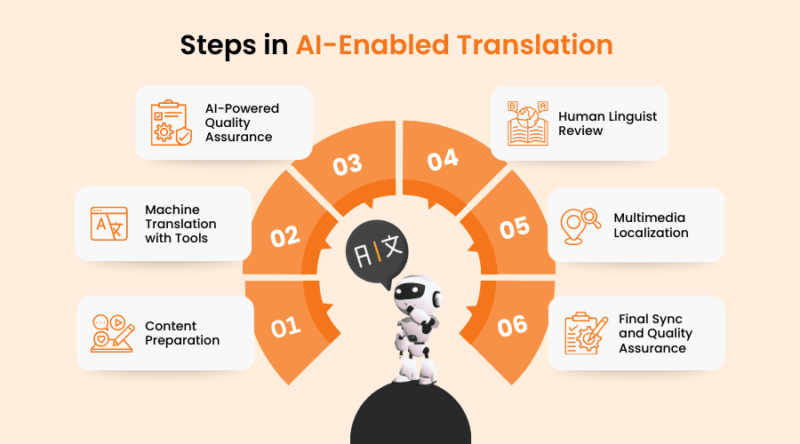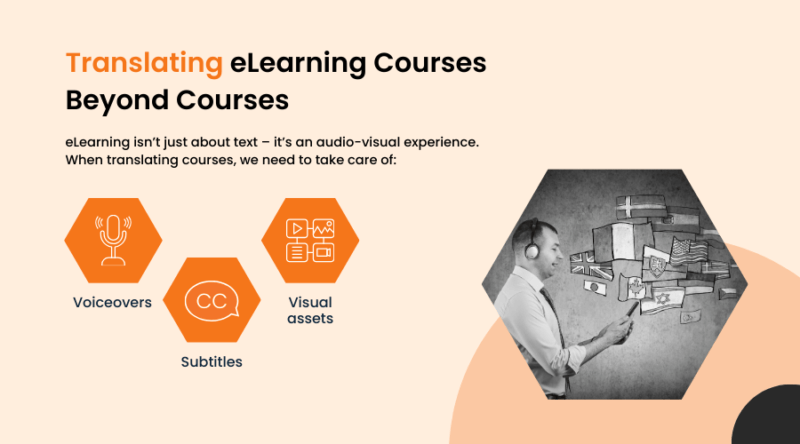Why Multilingual Learning Must Take Center Stage
In today’s corporate environment, providing training solely in one language is simply not sufficient. A vibrant and diverse workforce requires learning experiences that are both inclusive and accessible, starting with language. However, anyone who has tackled eLearning translations can attest that it is far from straightforward. Traditional translation methods are often slow, costly, and challenging to scale—leading to delays in training rollouts and added strain on Learning & Development (L&D) budgets.
Thanks to AI-powered translation tools, organizations can now localize eLearning courses with greater speed, consistency, and cost-effectiveness. Nevertheless, relying solely on Artificial Intelligence isn’t the end-all solution. The real breakthrough occurs when AI complements human expertise, delivering fast automation combined with the subtlety that only a human touch can provide. By utilizing AI platforms like Smartcat in conjunction with skilled human review, businesses can expand their training reach across borders without sacrificing quality.
Let’s dive deeper into how AI is revolutionizing the eLearning translation process: what works well, what challenges to anticipate, and how to effectively implement these strategies for your team.
Transitioning from Manual eLearning Translation to AI-Enhanced Localization
For years, translating eLearning content involved lengthy timelines, high costs, and coordination challenges. The process often included extracting content, sending it to translators, reformatting it upon return, and hoping everything synced properly within your authoring tool. Multiply this process by five or ten languages, and it’s easy to understand why many L&D teams either delayed localization or chose to bypass it entirely.
Today, however, the landscape has shifted. Modern localization begins with powerful machine translation platforms like Smartcat, which instantly translate large volumes of content while utilizing natural language processing to maintain tone, structure, and intent. What used to take weeks can now be accomplished in mere hours.
But remember, AI isn’t here to replace human talent—it enhances it. The optimal results emerge from a human-in-the-loop model, where linguists and Subject Matter Experts (SMEs), along with Instructional Designers, collaborate closely with AI to ensure that the final output is accurate, relevant, and pedagogically sound. This approach can reduce turnaround times by up to 50%, save nearly 40% on translation budgets, and enable seamless training across multiple regions without the usual delays.
How AI-Driven Translation Functions
For many L&D professionals, the term “AI translation” might evoke the image of a mysterious black box—simply inputting text in one language to get outputs in another. However, the process is remarkably structured and collaborative. Here’s a simplified overview of how AI-driven eLearning translation operates, particularly in a rapid eLearning context.

Image by CommLab India
Step 1: Preparing Content
The process kicks off by identifying what elements need translation from your customized eLearning course, including scripts, on-screen text, assessments, video narration, and UI components. Text is typically sourced from eLearning authoring tools such as Articulate Storyline or Rise, and is formatted for translation (usually XLIFF, Word, or CSV).
Step 2: Machine Translation Using Smartcat
This is where the heavy lifting occurs. Platforms like Smartcat utilize neural machine translation (NMT) engines to generate initial translations. These engines, trained on extensive datasets, improve their accuracy over time through learning from corrections.
Step 3: AI Quality Assurance
Tools like Smartcat incorporate automated quality assurance features that identify basic issues—such as missing punctuation, inconsistent terminology, or faulty tags.
Step 4: Review by Linguists
Professionals conduct a thorough review of the machine-generated content, correcting discrepancies in tone, cultural context, and technical language. This phase is essential for training material, where even minor errors could lead to confusion or compliance issues.
Step 5: Localizing Multimedia
Voiceovers are recorded using AI-generated speech or traditional narration, depending on the context and budget. Simultaneously, on-screen graphics with embedded text are localized, and subtitles are synchronized with the use of speech-to-text technology and human oversight.
Step 6: Final Review and Sync
The translated content is integrated back into the authoring tool, aligned with visuals, and rigorously tested for flow, formatting, and overall learner experience. Elements such as button labels and quiz logic are meticulously reviewed prior to full deployment.
This blend of AI and human involvement provides the speed necessary for the fast-evolving, multilingual training needs of global organizations without compromising on quality.
Rapid eLearning Meets AI Translation: A Perfect Match for Speed
Speed has consistently been a hallmark of rapid eLearning. Tools such as Articulate Storyline, Rise, and iSpring empower L&D teams to quickly create engaging, SCORM-compliant custom eLearning courses without lengthy production timelines. However, when it comes to multilingual delivery, speed can often stall—unless AI-driven translation is included from the start.
The modular design of rapid eLearning naturally aligns with AI translation. The content structure typically features short screens, microlearning segments, and templates that facilitate smooth localization. Pairing this with AI resources such as Smartcat enhances the translation process further.
Here’s how:
- Text extraction is organized and structured, simplifying integration with AI translation tools.
- Smartcat’s translation memory guarantees consistency across various screens and modules as content evolves.
- Translations can be swiftly reimported into tools like Rise or Storyline with minimal formatting adjustments.
- Multimedia components (voiceovers and subtitles) can be localized concurrently using AI voiceover and captioning tools.
This collaboration reduces turnaround times, mitigates human errors, and enables L&D teams to launch multilingual eLearning courses simultaneously, rather than in staggered phases.
Beyond Text: The Role of AI in Audio, Video, and Visual Localization
eLearning encompasses more than just text; it’s a rich multimedia experience. Voiceovers, subtitles, images featuring embedded text, and video content are integral to engaging learners. Neglecting these elements during localization can disrupt the learning experience for non-English speakers.

Image by CommLab India
AI Voiceovers
The quality of AI-generated voices has greatly improved, evolving from previous robotic tones to natural-sounding text-to-speech (TTS) outputs. Modern TTS engines can produce professional-grade voiceovers in multiple languages without the time and expense of traditional studio recordings. These voices can be tailored in tone, pace, gender, and even regional accents.
Automated Subtitling
Speech-to-text technologies can automatically generate subtitles for video content that align perfectly with narration. These captions can then be translated via AI and human-reviewed for clarity, particularly in complex technical training scenarios.
Visual Asset Localization
Images, infographics, and diagrams may contain embedded text that needs translation. AI-assisted tools can identify and extract this text, translate it, and reinsert it into the graphics, ensuring that learners see cohesive content in their native languages.
The Human-In-The-Loop Model: Achieving Accuracy Without Breaking the Bank
AI alone doesn’t ensure accuracy. Particularly when dealing with specialized, compliance-focused, or nuanced material, raw machine translation can falter. Terminology may be incorrect, and context can be overlooked. A simple mistranslation can lead to serious implications—something no L&D leader would want.
This is where a human-in-the-loop model proves invaluable. In this system, machine translation provides a quick initial draft, using pre-trained models and translation memories to expedite processing. However, human refinement becomes critical—the collaboration of skilled linguists, SMEs, and Instructional Designers ensures high quality.
Here’s how this model operates:
- Linguists ensure grammatical accuracy, tone consistency, and cultural appropriateness.
- SMEs validate technical accuracy and ensure domain-specific terminology is correct.
- Instructional Designers ensure that the educational intent and clarity remain intact across languages.
This layered approach strikes a balance between speed and precision, avoiding the inefficiencies of starting from scratch while minimizing risks associated with total reliance on AI.
Avoiding Common Pitfalls When Implementing AI Translation
While AI-driven eLearning translation can significantly enhance efficiency, it is not without its challenges. Many organizations make the mistake of launching into implementation without a solid strategy, leading to mediocre results, excess rework, and potential reputational risks.

Image by CommLab India
Below are some common pitfalls to avoid:
- Overdependence on raw machine output. AI translation may be fast but often lacks the nuance needed in context. Relying solely on it can result in loss of tone and intent, particularly in compliance or soft skills training.
- Inconsistent terminology. Without centralized glossaries or translation memory, terminology can vary across courses, leading to confusion.
- Ignoring cultural nuances. Direct translations can come off as awkward or inappropriate if cultural considerations aren’t taken into account. Adjustments to local idioms, humor, and visuals are often necessary.
- Overlooking multimedia elements. Text is but one facet of eLearning. Failing to address voiceovers, subtitles, and visual aspects results in an only partially localized course.
- Skipping the final quality check. Even with the best technology and human efforts, mistakes can happen. Conducting a final review within the authoring tool is crucial to catch layout issues, truncated text, or broken interactions.
When to Leverage AI-Powered Translation and When to Rely on Humans
AI-enhanced translation shines in high-volume, process-driven training scenarios. Think compliance modules, product training, software rollouts, and customer service guidelines, which are generally structured, repeatable, and can greatly benefit from velocity and consistency.
Conversely, for content that is emotionally charged, culturally sensitive, or pivotal to leadership development, fully human-led translation may be wise. Materials that hinge on storytelling, tone, or subtle persuasion often call for deeper human insight.
Ultimately, the key is discerning when to utilize AI and when to engage human expertise. At CommLab India, we assist clients in finding that balance tailored to their unique learning needs.
The Future of Translation in L&D: Intelligent, Scalable, and Inclusive
As we look ahead, the next phase of L&D is not merely digital; it’s inherently multilingual. As organizations scale into new markets and adapt to remote workforces, the demand for localized learning will become non-negotiable. The future lies in scalable, technology-driven solutions that simplify inclusivity.
As AI technology progresses, future tools will likely extend beyond text to include real-time communication, personalized language capabilities, and even AI-generated avatars delivering instruction in learners’ native tongues. Innovations in voice cloning, adaptive content, and feedback-driven models are emerging.
However, the winning strategy will not rely solely on technology. It will hinge on the thoughtful integration of AI with Instructional Design and human skill, ensuring that training is not only accurate but also impactful and culturally sensitive. The ultimate goal is not merely to produce multilingual content, but to create multilingual learning experiences that truly resonate.
Prepared for Multilingual Learning at the Speed of Business?
Training a global workforce goes beyond word-for-word translations; it involves imparting knowledge that resonates with learners, regardless of their location or language. AI-powered translation, when supplemented with human insights, empowers L&D teams to achieve this—faster, better, and more cost-effective than ever before.
Whether you’re scaling compliance training, launching new product education, or supporting multilingual onboarding, the right strategic approach can transform translation challenges into powerful enablers.
At CommLab India, we believe that the future of learning is intelligent, scalable, and inclusive. Importantly, it speaks every learner’s language.




